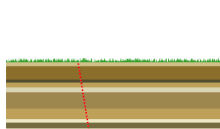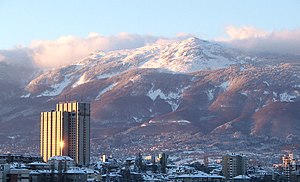Mountain formation


Mountain formation refers to the geological processes that underlie the formation of mountains. These processes are associated with large-scale movements of the Earth's crust (tectonic plates).[1] Folding, faulting, volcanic activity, igneous intrusion and metamorphism can all be parts of the orogenic process of mountain building.[2] The formation of mountains is not necessarily related to the geological structures found on it.[3]
From the late 18th century until its replacement by plate tectonics in the 1960s, geosyncline theory was used to explain much mountain-building.[4] The understanding of specific landscape features in terms of the underlying tectonic processes is called tectonic geomorphology, and the study of geologically young or ongoing processes is called neotectonics.[5][clarification needed]
Types of mountains
There are five main types of mountains: volcanic, fold, plateau, fault-block, and dome. A more detailed classification useful on a local scale predates plate tectonics and adds to these categories.[6]
Volcanic mountains
Movements of tectonic plates create volcanoes along the plate boundaries, which erupt and form mountains. A volcanic arc system is a series of volcanoes that form near a subduction zone where the crust of a sinking oceanic plate melts and drags water down with the subducting crust.[9]

Most volcanoes occur in a band encircling the Pacific Ocean (the
A shield volcano has a gently sloping cone because of the low viscosity of the emitted material, primarily
Fold mountains
When
Block mountains


When a fault block is raised or tilted, a block mountain can result.[17] Higher blocks are called horsts, and troughs are called grabens. A spreading apart of the surface causes tensional forces. When the tensional forces are strong enough to cause a plate to split apart, it does so such that a center block drops down relative to its flanking blocks.
An example is the Sierra Nevada range, where delamination created a block 650 km long and 80 km wide that consists of many individual portions tipped gently west, with east facing slips rising abruptly to produce the highest mountain front in the continental United States.[18][19]
Another example is the
Uplifted passive margins
Unlike orogenic mountains there is no widely accepted geophysical model that explains elevated passive continental margins such as the Scandinavian Mountains, eastern Greenland, the Brazilian Highlands, or Australia's Great Dividing Range.[23][24] Different elevated passive continental margins most likely share the same mechanism of uplift. This mechanism is possibly related to far-field stresses in Earth's lithosphere. According to this view elevated passive margins can be likened to giant anticlinal lithospheric folds, where folding is caused by horizontal compression acting on a thin to thick crust transition zone (as are all passive margins).[25][26]
Models
Hotspot volcanoes
Hotspots are supplied by a magma source in the Earth's mantle called a mantle plume. Although originally attributed to a melting of subducted oceanic crust, recent evidence belies this connection.[27] The mechanism for plume formation remains a research topic.
Fault blocks
Several movements of the Earth's crust that lead to mountains are associated with faults. These movements actually are amenable to analysis that can predict, for example, the height of a raised block and the width of an intervening rift between blocks using the rheology of the layers and the forces of isostasy. Early bent plate models predicting fractures and fault movements have evolved into today's kinematic and flexural models.[28][29]
See also
- 3D fold evolution
- Continental collision – Phenomenon in which mountains can be produced on the boundaries of converging tectonic plates
- Cycle of erosion – Model of geographic landscape evolution
- Inselberg – Isolated, steep rock hill on relatively flat terrain
- Seamount – Mountain rising from the ocean seafloor that does not reach to the water's surface
References
- ISBN 978-0-7167-3907-4.
- ISBN 978-0-7167-2252-6.
- ISBN 978-0-415-19890-5.
- ^ "Geosynclinal Theory". publish.illinois.edu. University of Illinois at Urbana-Champaign. Retrieved March 8, 2018.
The major mountain-building idea that was supported from the 19th century and into the 20th is the geosynclinal theory.
- ISBN 978-3-540-71236-7.
- ISBN 978-0-415-32738-1.
- ^ NASA - Activity at Kliuchevskoi
- ISBN 978-0-7872-9355-0.
- ISBN 978-0-7668-3391-3.
- ISBN 978-0-262-07128-4.
- ISBN 978-0-7167-8929-1.
- ISBN 978-0-7487-4381-0.
- ^ Transactions of the American Society of Civil Engineers, Volume 39. American Society of Civil Engineers. 1898. p. 62.
- ISBN 978-0-618-93596-3.
- ISBN 978-0-8137-1200-0.
- ISBN 9780415217705.
- ISBN 978-0-471-78937-6.
- ISBN 978-0-262-07128-4.
- PMID 10988067. Archived from the original(PDF) on 2011-06-15.
- ^ Мичев (Michev), Николай (Nikolay); Михайлов (Mihaylov), Цветко (Tsvetko); Вапцаров (Vaptsarov), Иван (Ivan); Кираджиев (Kiradzhiev), Светлин (Svetlin) (1980). Географски речник на България [Geographic Dictionary of Bulgaria] (in Bulgarian). Sofia: Наука и култура (Nauka i kultura). p. 368.
- ^ Димитрова (Dimitrova), Людмила (Lyudmila) (2004). Национален парк "Пирин". План за управление [Pirin National Park. Management Plan] (in Bulgarian). и колектив. Sofia: Ministry of Environment and Water, Bulgarian Foundation "Biodiversity". p. 53.
- ISBN 954-649-717-7.
- ^ Bonow, Johan M. (2009). "atlantens kustberg och högslätter – gamla eller unga?" (PDF). www.geografitorget.se (in Swedish). Geografilärarnas Riksförening.
- .
- .
- ^ Løseth and Hendriksen 2005
- ISBN 978-3-540-40859-8.
- ISBN 978-0-521-00600-2.
- ISBN 978-1-86239-051-5.

